(If you came to this blog post via pinterest, please take a look here too, to find many other interesting subjects.)
The Corner of the Folded Peahole Edging
The folded Peahole edging can be easily worked along a straight edge, but one can also turn corners while stitching this edging.
Shown here is a practice exercise only.
First, some distance from both edges, withdraw threads for the folded Peahole.
 Starting at the point shown in the picture below,
Starting at the point shown in the picture below,
 work a number (it doesn’t matter the exact number since this is a practice piece, but it should be an even number) of Four-Sided stitches.
work a number (it doesn’t matter the exact number since this is a practice piece, but it should be an even number) of Four-Sided stitches.
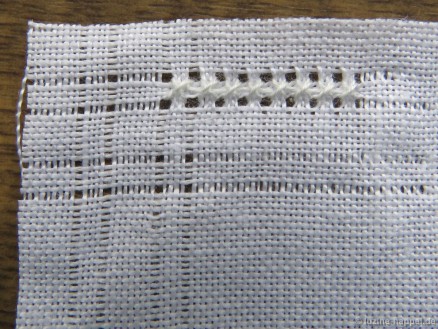 Turn the piece 180° and work Four-Sided stitches lined up to the first row of Four-Sided stitches.
Turn the piece 180° and work Four-Sided stitches lined up to the first row of Four-Sided stitches.
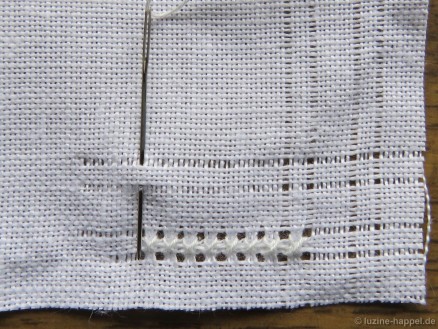 Work them around the corner.
Work them around the corner.
 Starting at the place shown in the picture below,
Starting at the place shown in the picture below,
 work the remaining Four-Sided stitches.
work the remaining Four-Sided stitches.
 Withdraw the threads for the Peaholes
Withdraw the threads for the Peaholes
 and work the wrapped Peaholes.
and work the wrapped Peaholes.
 Cut the corner diagonally so that the cut is directly outside the Four-Sided stitches—taking care not to damage them.
Cut the corner diagonally so that the cut is directly outside the Four-Sided stitches—taking care not to damage them.
 Along one edge, fold the edging so that the backs of the Four-Sided stitches lie on top of each another and begin securing the triangles.
Along one edge, fold the edging so that the backs of the Four-Sided stitches lie on top of each another and begin securing the triangles.
 Reaching the corner, fold the edging of the perpendicular side
Reaching the corner, fold the edging of the perpendicular side
 and continue securing the triangles around the corner.
and continue securing the triangles around the corner.
 From the back it looks like this:
From the back it looks like this:
 Four threads inwards from the bottom of the previously worked Four-Sided stitches, withdraw one more thread along each side (on both the front and the back). (Please carefully look at the picture!)
Four threads inwards from the bottom of the previously worked Four-Sided stitches, withdraw one more thread along each side (on both the front and the back). (Please carefully look at the picture!)
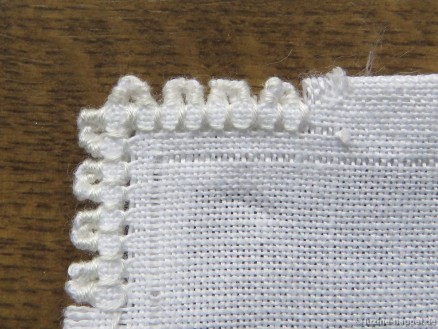 From the front of the fabric, work one row of Four-Sided stitches catching both layers.
From the front of the fabric, work one row of Four-Sided stitches catching both layers.
 Now, on the back side, trim the remaining fabric close to the stitches.
Now, on the back side, trim the remaining fabric close to the stitches.
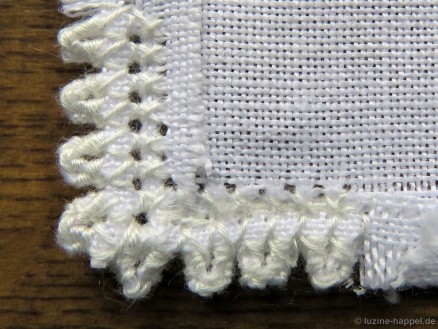 A nice hem is created – admittedly, the triangles in this example are not the best (this was one of my first attempts at working this edging, since then they have improved a lot).
A nice hem is created – admittedly, the triangles in this example are not the best (this was one of my first attempts at working this edging, since then they have improved a lot).
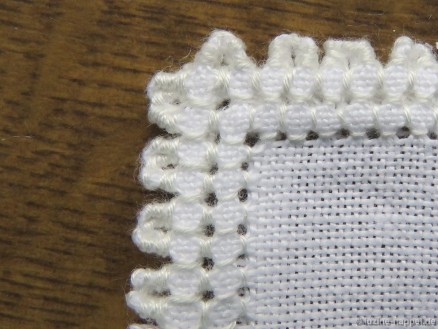
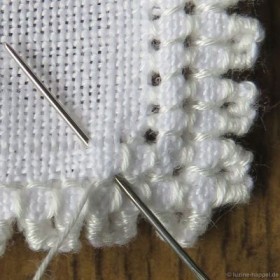


Hallo, Liebe Luzine !
Dies ist fuer mich ganz rechtzeitig !
Die Information ist immer praktisch. Danke !!
Viel Spaß beim Nacharbeiten, liebe Yasuko!
Vielen Dank Luzine, eine sehr schöne Erbslochkante!
Danke, Jeanny!
Bei einem breiten Saum sieht die Erbslochkante auch sehr gut aus. Gerade arbeite ich daran. Die Beschreibung dazu veröffentliche ich demnächst.
Schon vielen Dank!
I learn so much from your blog! Thank you!
Thanks, Donna,
I post subjects on my blog for people willing to learn. And I am happy, if people take use of it.
I learned a lot from your blog too and this tutorial is so pretty! Thank you!
Amazing!! I’ve never never see this technique!!
Did you ever try to apply on a biggest work? Like curtains??
Because I’m looking for a good edge for the curtains, a normal edge has no strength and is difficult to make stable.
Really compliments!
For curtains I would take the hem you can see in the article “A Wide Hem with a Folded Peahole Edging”, adding one or two rows of Four-Sided stitches beside the edging.
But it is not easy to work. Best, you make a practice exercise before.
Hi,
Does the item fray or do you weave in the threads?
Regards
Sorry, your comment got into my spam folder. So I just now found it.
No, I did not weave in the fabric threads. In carefully handling the item does not fray.
Hi Luzine, I am looking for a pretty, yet different hem and I find this so beautiful and just what I am looking for.
One always find what you need in your blogs, old and recent.
Thank you so much and your instructions are so carefully and precise.
Regards
Hannie Cripps
Hi Hannie,
Nice to hear from you.Thank you for the compliments. I always try to show different interesting contents – Schwalm whitework, traditional and contemporary, and also Schwalm coustumes and what we can learn from the work of our forebears.
bellissimo!!!
Thank you so much! This looks like a nice alternative to Hardanger edging!
Felicitaciones, muy hermoso tu trabajo. Es muy fácil de aplicar porque está muy bien explicado en el paso a paso de cómo se debe realizar.
Un cordial saludo desde Chile
Gracias por el cumplido Estaba muy feliz por eso.
Hallo Frau Happel,
bin gerade dabei diese Kante zu sticken. Ihre Anleitung dazu ist eine große Hilfe. Jetzt habe ich aber ein Problem. Wie schummel ich wenn ich am Ende kein zweier Bündel mehr machen kann. Hatte mich verzählt und nun bleiben einmalig 4 Fäden stehen. Umwickeln und wie dann die Ecke machen?
Gruß
Anja
Ein einzelnes Bündel ist nicht so geeignet, weil es beim Falten nicht so eine schöne Spitze bildet. Entweder, Sie nehmen das einzelne Bündel zum letzten Erbsloch dazu, dann wird die Spitze etwas breiter. Oder aber Sie teilen das letzte Bündel und machen 2 x 2-Fadenbündel daraus. Dann können Sie daraus ein Erbsloch bilden und erhalten eine schmalere Spitze.
I am so excited to see this embroidery blog. I’m literally ecstatic. I love this edging and I see it in some of the old hankies I had gotten at antique stores. But I could never find the instructions. I’ve gotten embroidery books but nothing explaining It like you have. I love your pictures and all the detail. Thank you so much for posting this.
Carol
Thank you for the compliment, Carol. I myself do not like imperfect explanations, because they do not really help. So I always try to write my descriptions clear and understandable.